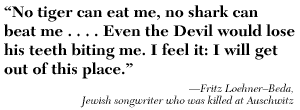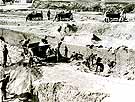
|
|
|

|

|

|

|
|
Click on an image to see a larger, more detailed picture.
|
|
|
|
|
| 1942: The "Final Solution" |

|
pg. 317 |

|
|
|
|
| |

|
 The Mauthausen concentration camp, located near Linz in upper Austria, was renowned for its cruel working conditions. The camp included within its confines a stone quarry in which prisoners were assigned to backbreaking work. While pushing heavy carts or carrying stones weighing over 100 pounds, prisoners were forced to ascend the "staircase of death." Composed of 186 steps, the staircase meant death for any prisoner who lost his or her footing and fell under the loads. Later in the war Mauthausen prisoners were assigned to build underground tunnels for weapons production.
The Mauthausen concentration camp, located near Linz in upper Austria, was renowned for its cruel working conditions. The camp included within its confines a stone quarry in which prisoners were assigned to backbreaking work. While pushing heavy carts or carrying stones weighing over 100 pounds, prisoners were forced to ascend the "staircase of death." Composed of 186 steps, the staircase meant death for any prisoner who lost his or her footing and fell under the loads. Later in the war Mauthausen prisoners were assigned to build underground tunnels for weapons production.
Photo: Rijksinstituut voor Oorlogsdocumentatie / United States Holocaust Memorial Museum Photo Archive
|
 Political prisoners were among the first inmates of Mauthausen, including more than 7000 Spanish Republicans, some of whom are pictured. The Spanish Republicans had sought sanctuary in France but were deported by the French Vichy government. Hungarians, Poles, and Czechs--including many Jews--also were sent to Mauthausen. The cruel conditions of the camp were set by its commandant, Franz Ziereis, nicknamed "Babyface" by the prisoners.
Political prisoners were among the first inmates of Mauthausen, including more than 7000 Spanish Republicans, some of whom are pictured. The Spanish Republicans had sought sanctuary in France but were deported by the French Vichy government. Hungarians, Poles, and Czechs--including many Jews--also were sent to Mauthausen. The cruel conditions of the camp were set by its commandant, Franz Ziereis, nicknamed "Babyface" by the prisoners.
Photo: National Archives / United States Holocaust Memorial Museum Photo Archive
|
 This woman resided in Kerch in the Crimean Peninsula of the Soviet Union. The Jews of Crimea were murdered up through April 1942. That month the Germans declared the Crimea judenrein (cleansed of Jews).
This woman resided in Kerch in the Crimean Peninsula of the Soviet Union. The Jews of Crimea were murdered up through April 1942. That month the Germans declared the Crimea judenrein (cleansed of Jews).
Photo: Yad Vashem
|
|

|

|

|

|
 May 1942: Slovakian Jews and resident Jews at Chelm are deported to the nearby Sobibór death camp and gassed. In addition, more than 36,000 Polish Jews from communities located between the Vistula and Bug rivers are gassed at Sobibór.
May 1942: Slovakian Jews and resident Jews at Chelm are deported to the nearby Sobibór death camp and gassed. In addition, more than 36,000 Polish Jews from communities located between the Vistula and Bug rivers are gassed at Sobibór.
|
 May 1942: In the Eastern Galicia region of Poland, Jews aged 14 to 60 are driven to isolated spots and killed by hand grenades and machine guns after being forced to dig their own graves. Other victims of this Aktion include orphans, residents of old-age homes, and women in the streets.
May 1942: In the Eastern Galicia region of Poland, Jews aged 14 to 60 are driven to isolated spots and killed by hand grenades and machine guns after being forced to dig their own graves. Other victims of this Aktion include orphans, residents of old-age homes, and women in the streets.
|
 May 1942: Inmates at Auschwitz-Birkenau are put to work as slave laborers at the camp itself and at a synthetic-oil and rubber plant at nearby Monowitz.
May 1942: Inmates at Auschwitz-Birkenau are put to work as slave laborers at the camp itself and at a synthetic-oil and rubber plant at nearby Monowitz.
|
 May 1942: Jewish women at Auschwitz-Birkenau are selected for medical experiments.
May 1942: Jewish women at Auschwitz-Birkenau are selected for medical experiments.
|
 May 1942: A Jewish inmate at a labor camp at Schwenningen, Germany, is buried in earth up to his shoulders as punishment for having an attack of diarrhea outside a barracks; after more than ten hours in the ground, the man dies.
May 1942: A Jewish inmate at a labor camp at Schwenningen, Germany, is buried in earth up to his shoulders as punishment for having an attack of diarrhea outside a barracks; after more than ten hours in the ground, the man dies.
|
|
|
|
|
| 1942: The "Final Solution" |

|
pg. 317 |

|
|
The Holocaust Chronicle
© 2009 Publications International, Ltd.
|
|
